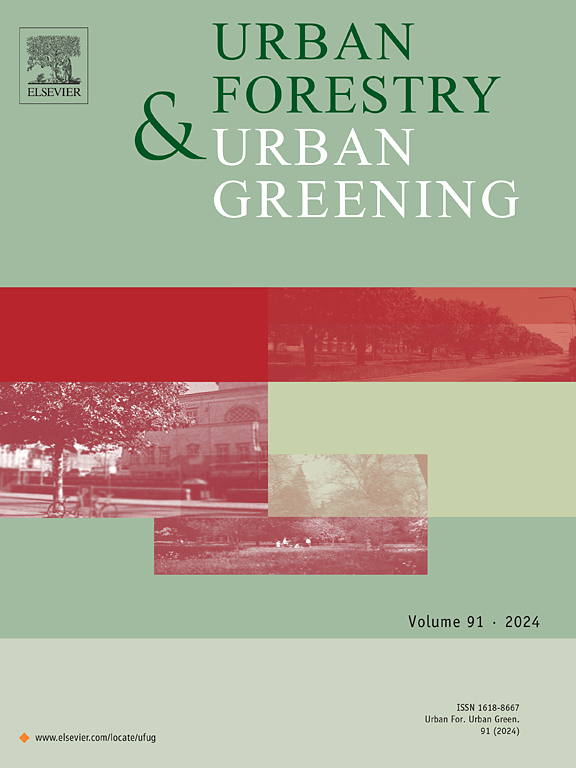Identifying climate-ready plant for urban environment: Integrating machine learning with traditional plant selection tools
IF 6
2区 环境科学与生态学
Q1 ENVIRONMENTAL STUDIES
引用次数: 0
Abstract
Climate change has intensified the urban heat island effect and increased extreme weather conditions, posing risks to public health and urban vegetation. To address these challenges, selecting climate-ready urban plant species is crucial. Traditional climate niche-based methods often fall short in urban contexts due to neglecting anthropogenic factors. Our study addresses this research gap by introducing an innovative urban plant selection method that integrates vulnerability metrics, expert consensus, and plant introduction records through machine learning. We identified eight climatic variables essential for the survival of urban plants in Beijing, China, and established safety margins for eight climate variables of 1070 urban plant species across two periods: the baseline (1981–2010) and the future (2041–2070). Based on existing assessment data, expert consensus and plant introduction records, 247 plant species were classified into three levels of adaptability: backbone (highly adaptable, prevalent in Beijing), general (moderately adaptable, requiring specific care), and maladapted (poorly adaptable). Subsequently, we investigated the dynamic relationship between safety margins for eight climate variables across two time periods and the adaptability levels of plants by constructing an optimal machine learning model to predict urban plant adaptability levels, enhancing its accuracy through model comparisons and hyperparameter tuning. Our findings indicate that nearly half (49.0 %) of the plant species in Beijing may face reduced adaptability to future climate conditions. However, a majority (75.9 %) perform well under baseline climate conditions and are expected to adapt to future climate conditions. The results reaffirm that the species can grow well out of the niche limit, suggesting that the traditional climate niche-based method may be limited in urban contexts. Our approach overcomes the limitations of binary classification of traditional niche-based methods and the neglect of anthropogenic factors by incorporating an urban plant adaptability classification schema and ground truth derived from expert consensus and records of plant introductions through machine learning methods. This study provides a method for selecting climate-ready plant species for urban environments and supports evidence-based urban forestry management amidst climate change.
为城市环境识别适应气候的植物:将机器学习与传统植物选择工具相结合
气候变化加剧了城市热岛效应,增加了极端天气条件,给公众健康和城市植被带来了风险。为应对这些挑战,选择适应气候的城市植物物种至关重要。由于忽略了人为因素,传统的基于气候生态位的方法在城市环境中往往不尽如人意。我们的研究引入了一种创新的城市植物选择方法,通过机器学习整合了脆弱性指标、专家共识和植物引种记录,从而弥补了这一研究空白。我们确定了对中国北京城市植物生存至关重要的八个气候变量,并为 1070 种城市植物物种的八个气候变量建立了两个时期的安全系数:基线(1981-2010 年)和未来(2041-2070 年)。根据现有评估数据、专家共识和植物引种记录,我们将 247 种植物的适应性分为三个等级:骨干(适应性强,在北京普遍存在)、一般(适应性一般,需要特殊照顾)和不适应(适应性差)。随后,我们通过构建一个最佳机器学习模型来预测城市植物的适应性水平,并通过模型比较和超参数调整来提高其准确性,从而研究了两个时间段内八个气候变量的安全系数与植物适应性水平之间的动态关系。我们的研究结果表明,北京近一半(49.0%)的植物物种对未来气候条件的适应性可能会降低。然而,大多数物种(75.9%)在基准气候条件下表现良好,有望适应未来气候条件。研究结果再次证实,这些物种可以在生态位极限之外生长,这表明传统的基于气候生态位的方法在城市环境中可能存在局限性。我们的方法克服了传统的基于生态位的二元分类方法的局限性和对人为因素的忽视,通过机器学习方法纳入了城市植物适应性分类模式和来自专家共识和植物引种记录的基本事实。这项研究提供了一种为城市环境选择适应气候的植物物种的方法,并支持在气候变化中以证据为基础的城市林业管理。
本文章由计算机程序翻译,如有差异,请以英文原文为准。
求助全文
约1分钟内获得全文
求助全文
来源期刊

Urban Forestry & Urban Greening
FORESTRY-
CiteScore
11.70
自引率
12.50%
发文量
289
审稿时长
70 days
期刊介绍:
Urban Forestry and Urban Greening is a refereed, international journal aimed at presenting high-quality research with urban and peri-urban woody and non-woody vegetation and its use, planning, design, establishment and management as its main topics. Urban Forestry and Urban Greening concentrates on all tree-dominated (as joint together in the urban forest) as well as other green resources in and around urban areas, such as woodlands, public and private urban parks and gardens, urban nature areas, street tree and square plantations, botanical gardens and cemeteries.
The journal welcomes basic and applied research papers, as well as review papers and short communications. Contributions should focus on one or more of the following aspects:
-Form and functions of urban forests and other vegetation, including aspects of urban ecology.
-Policy-making, planning and design related to urban forests and other vegetation.
-Selection and establishment of tree resources and other vegetation for urban environments.
-Management of urban forests and other vegetation.
Original contributions of a high academic standard are invited from a wide range of disciplines and fields, including forestry, biology, horticulture, arboriculture, landscape ecology, pathology, soil science, hydrology, landscape architecture, landscape planning, urban planning and design, economics, sociology, environmental psychology, public health, and education.
 求助内容:
求助内容: 应助结果提醒方式:
应助结果提醒方式:


